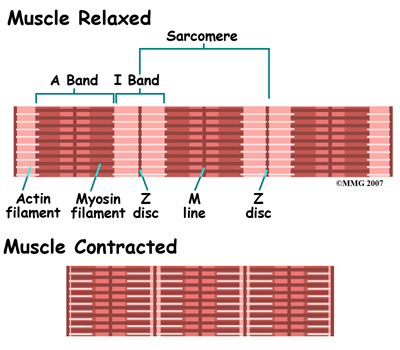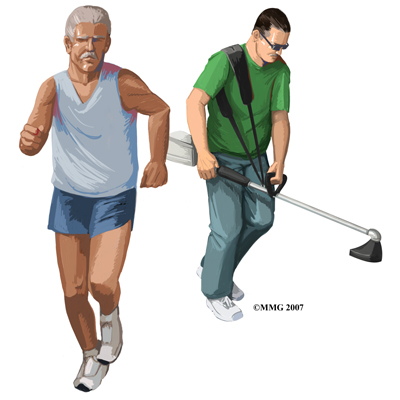What causes muscle cramps?

To move your muscles, your brain sends signals to the voluntary muscles and coordinates the movements that you want. The voluntary muscles contract as they're being used and they become tighter. The muscles then relax when the movement is complete. When the contraction/relaxation cycles are done repeatedly, as in exercising, the fibers become stronger and the muscles get larger and stronger. However, sometimes the muscles, or just a few fibers within the muscle, contract on their own, causing a muscle spasm or cramp. The difference between a spasm and a cramp is the force of the contraction. If it's a quick contraction and release of muscle, without pain, it's a spasm. If the contraction is prolonged and painful, it's a cramp. Occasionally, cramps are so intense that you can't use your muscle because it's so tight and painful. Cramps can be short-lived, a minute or less, or as long as a couple of days. When researchers tested the cramping muscles of some athletes, they found rapid repetitive muscle firing, which could be described as the muscle fibers being hyperactive, in a sense.
Cramps can happen in one muscle, like the hamstring, or they can happen in a number of muscles together, like in your hands if you have writer's cramp. They can happen once and then not again, or there can be a series of on-again-off-again cramping.
There are several reasons why muscle cramps may occur, including the most common one that is seen in both professional and weekend athletes. These are called exercise-associated muscle cramping or EAMC. These types of cramps fall under the category of paraphysiologic cramps. Those are cramps that affect normally healthy people but are brought on by an event, such as exercise.
Researchers have estimated that marathon runners and triathletes may have a 30 to 67 percent lifetime risk of developing these cramps. Although the exact cause of the cramping isn't known, researchers do believe that they can be caused by inadequate stretching, muscle fatigue, or lack of oxygen to the muscle. Other causes can also include heat, dehydration, and/or lack of salt and minerals (electrolytes). New research suggests that there may be abnormal motor neuron (nerve) activity at the level of the spine.
Researchers also have noticed that the athletes who suffer from a lot of cramping tend to be older, marathon runners, or have a high body mass index. They don't stretch regularly, and have a family history of muscle cramps.
Cramps can also happen if you use the same muscles in the same way for too long a period. This could be as you crouch down to work in the garden, type on a keyboard, or write out long lists with paper and pen. The muscles contract and cause the pain.

Occasionally, these types of cramps seemingly come out of nowhere. For example, as we stretch, we often point our toes downward. This motion contracts the muscle in the calf of the leg and can cause a severe cramp or charley horse.
Women who are pregnant may also find that they get more muscle cramps during their pregnancy, but the reason why isn't clear. Again, these are considered to be paraphysiologic cramps because they are brought on by the pregnancy. Along the same vein, seniors may also be prone to developing muscle cramps. Doctors believe this is due to loss of muscle mass as people age plus inactivity.
Muscle cramps can also occur as a side effect of medications. Diuretics, or water pills, cause you to eliminate fluid from your body. If too much fluid is eliminated too quickly, the resulting dehydration could cause muscle cramps. Other medications can also cause muscle cramps.
Skeletal problems can increase the chances of leg cramps. For example, people with problems like scoliosis (curvature of the spine) could have one leg longer than the other. This imbalance can cause cramping in the leg.
Symptomatic cramps are, as the name suggests, symptoms of an illness that may be causing the cramping. Examples of a few illnesses that can cause muscle cramping are: Parkinson's disease, tetanus, diabetes, and heart disease. Atherosclerosis (hardening of the arteries) makes it hard for blood to circulate throughout the body as it should. Often, one of the first signs of atherosclerosis is a symptom called claudication or intermittent claudication. Someone who has atherosclerosis may start feeling cramping in one or both legs after walking for a while. At rest, the pain disappears, but it comes back when the person resumes walking.
Radiculopathy (irritation of the nerve root at the spine) is a known cause for muscle cramping, usually at night. Some other illnesses that can cause muscle cramping are cirrhosis of the liver, Black Widow spider bites, and malignant hyperthermia, among others.
Finally, idiopathic muscle cramps are cramps that have no known cause but they are symptoms of a disease, or can be inherited. Sudden nocturnal (occurring at night) leg cramps are an example of this type of cramping.









 (403) 679-7179
(403) 679-7179  concierge@one-wellness.ca
concierge@one-wellness.ca 

